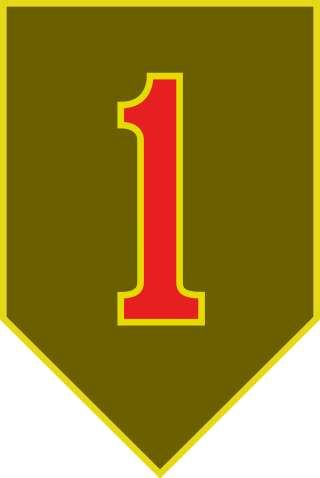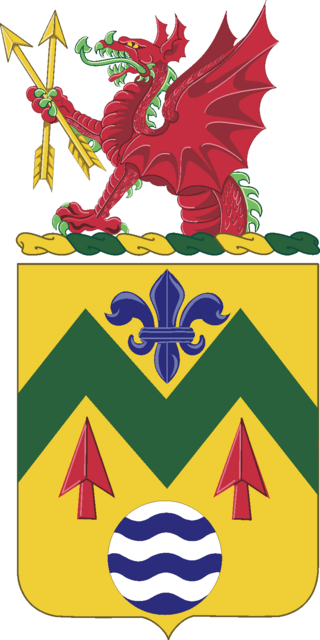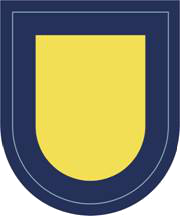
The 11th Armored Cavalry Regiment is a unit of the United States Army garrisoned at the Fort Irwin National Training Center in California. Although termed an armored cavalry regiment, it is being re-organized as a multi-component heavy brigade combat team. The regiment has served in the Philippine–American War, the Pancho Villa Expedition, World War II, the Vietnam War, Gulf War and Iraq War. The 11th ACR serves as the opposing force (OPFOR) for the Army and Marine task forces, and foreign military forces that train at Fort Irwin.

The United States Army Quartermaster Corps, formerly the Quartermaster Department, is a sustainment and former combat service support (CSS) branch of the United States Army. It is also one of three U.S. Army logistics branches, the others being the Transportation Corps and the Ordnance Corps.

The brigade combat team (BCT) is the basic deployable unit of maneuver in the U.S. Army. A brigade combat team consists of one combat arms branch maneuver brigade, and its assigned support and fire units. A brigade is normally commanded by a colonel (O-6) although in some cases a brigadier general (O-7) may assume command. A brigade combat team contains combat support and combat service support units necessary to sustain its operations. BCTs contain organic artillery training and support, received from the parent division artillery (DIVARTY). There are three types of brigade combat teams: infantry, Stryker, and armored.

The 7th Engineer Support Battalion is an engineering support unit of the United States Marine Corps and is headquartered at Marine Corps Base Camp Pendleton, California. The unit falls under the command of 1st Marine Logistics Group and the I Marine Expeditionary Force.

The Royal Australian Army Ordnance Corps (RAAOC) is the Corps within the Australian Army concerned with supply and administration, as well as the demolition and disposal of explosives and salvage of battle-damaged equipment. The Corps contains clerks, operator supplies, petroleum operators, parachute riggers and ammunition technicians. Members of the Corps are nicknamed Roaches.
A special troops battalion (STB) is an organic unit of a modular brigade, division, corps or higher echelon United States Army organization. It may comprise companies from different branches of the army, but typically has a Headquarters and Headquarters Company (HHC) and Signal Network Company at a minimum.

The 1982 British military campaign to recapture the Falkland Islands depended on complex logistical arrangements. The logistical difficulties of operating 7,000 nautical miles from home were formidable. The Argentine invasion of the Falkland Islands came at a time when the Royal Navy was experiencing a reduction in its amphibious capability, but it still possessed the aircraft carriers HMS Hermes and Invincible, the landing platform dock (LPD) ships HMS Fearless and Intrepid, and six landing ship logistics (LSL) ships. To provide the necessary logistic support, the Royal Navy's ships were augmented by ships taken up from trade (STUFT).

The 1st Infantry Division Sustainment Brigade is a sustainment brigade of the United States Army based at Fort Riley, Kansas. It provides logistics support to the 1st Infantry Division.

The 528th Support Battalion is a battalion of the United States Army. The 528th Support Battalion's mission is to provide rapidly deployable CSS and HSS to ARSOF as directed. The 528th Support Battalion's strengths lie in its capability to support ARSOF-unique and low-density weapons and vehicles. The 528th complements [organic] 22 ARSOF CSS, HSS, and signal units. The support battalion consists of a headquarters and main support company (HMSC), three forward support companies and may receive augmentation from Theater Army. As part of Army Special Operations Command the unit, along with the 112th Signal Battalion, is tasked to provide full logistical support to Army Special Operations Forces forming along with several other units what was known as Special Operations Support Command, later reorganized as the 528th Sustainment Brigade (A). The Brigade Troops Battalion includes a wide variety of military occupation specialists: riggers, drivers, medics, mechanics, engineers, fuelers, cooks, etc.
The 68th Division Sustainment Support Battalion is a U.S. Army support battalion stationed at Fort Carson, Colorado. The Battalion motto is "Stagecoach, LET'S GO". The 68th Division Sustainment Support Battalion's current call sign is "Stagecoach". The 68th DSSB has deployed overseas to India, Burma, Somalia, Cuba, Kuwait, Saudi Arabia, Iraq, and Afghanistan.

Combat Logistics Battalion 31 (CLB-31) is a logistics battalion of the United States Marine Corps. CLB-31 is the Logistics Combat Element (LCE) of the 31st Marine Expeditionary Unit, the only continuously forward-deployed MEU in the Marine Corps.

The 230th Brigade Support Battalion is a support unit of the 30th Armored Brigade Combat Team, North Carolina Army National Guard. Battalion headquarters is at Goldsboro, North Carolina. The 230th BSB currently has companies in the following locations in North Carolina, West Virginia and South Carolina:
13th Combat Sustainment Support Battalion is a modular, corps-level support organization Battalion responsible for providing multifunctional logistics support to maneuver, fires, and effects organizations as well as multifunctional logistics assistance to other support organizations. The 13th CSSB was formerly stationed at Fort Benning, Georgia, and was a subordinate unit of the 3rd Sustainment Brigade. The battalion was deactivated in October 2011 at Ft Benning and reflagged from the former 80th Ordnance Battalion at Joint Base Lewis/McChord. The battalion is now subordinate to the 593rd Expeditionary Sustainment Command.
The 59th Quartermaster Company is a bulk petroleum company designed to provide semi-portable storage for 2.5 million US gallons (9,500 m3) of fuel and to provide distribution of fuel to military units within a specified geographic area while deployed overseas. Its secondary mission is to provide an armed military escort to military cargo and civilian trucks during overseas contingency operations. It is a U.S. Army Forces Command combat service support unit stationed at Fort Carson, Colorado under the command of the 68th Combat Sustainment Support Battalion. The 59th has deployed overseas to Algeria, Italy, France, Germany, Korea, Vietnam, Kuwait, Saudi Arabia, Iraq, and Afghanistan. The 59th is the only bulk petroleum company in the Regular Army; all sister units are part of the Army Reserve as of 2011.

104 Theatre Sustainment Brigade is a specialist logistic support formation of the British Army. The brigade is the only one of its kind, and as such contains many of the special units of the Royal Logistic Corps and Royal Electrical and Mechanical Engineers.

The 601st Quartermaster Company is an Aerial Delivery Support Company of the United States Army based in Aviano, Italy. It is a subordinate unit of the 173rd Support Battalion. The members are primarily Parachute Riggers who are responsible for the packing, storage, maintenance and issuing of both personnel and heavy drop aerial delivery support.

Logistics played a key role in the success of Operation Dragoon, the Allied invasion of Southern France during World War II that commenced with the US Seventh Army landings on the French Riviera on 15 August 1944. On 12 September, the Seventh Army made contact with Allied forces that had landed in Normandy earlier that year as part of Operation Overlord. The supporting logistical organizations continued to operate separately, with the Southern Line of Communications supporting the Seventh Army drawing its supplies from the North African Theater of Operations until it merged with the Communications Zone of the European Theater of Operations on 20 November.
A brigade support battalion (BSB) is a combat service support battalion of the United States Army. A BSB is an organic part of a brigade combat team (BCT), providing self-sustainment to the BCT for up to 72 hours of high-intensity combat before requiring replenishment. It consists of a headquarters and headquarters company, field maintenance company, distribution company, medical company, and a forward support company assigned to each of the other battalions in the BCT.
142nd Division Sustainment Support Battalion is a multifunctional logistics headquarters. It is task organized as a Division Sustainment Support Battalion with capability required to support specified mission requirements. The CSSB supports echelon above brigade units, multifunctional brigades, functional support brigades, and brigade combat teams. The CSSB may support Army special operations forces as part of their area support task. The 142nd DSSB is currently stationed at Fort Bliss, Texas, and is a subordinate unit of the 1st Armored Division Sustainment Brigade.












